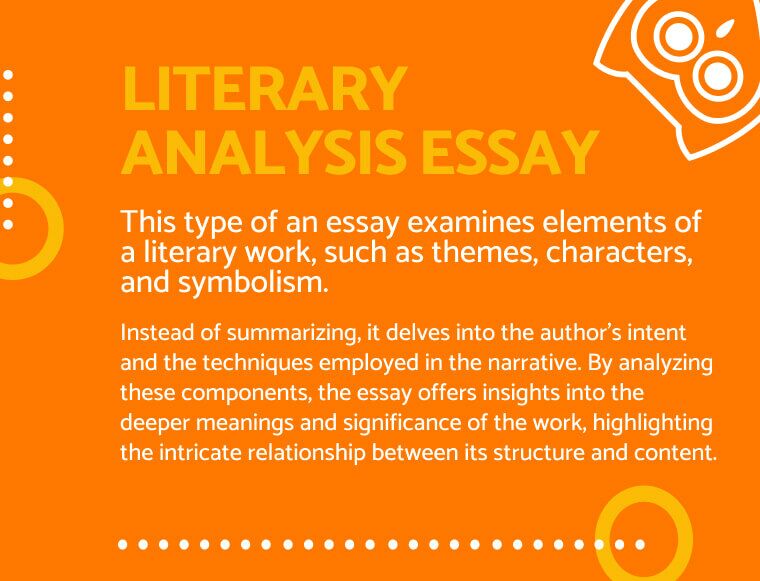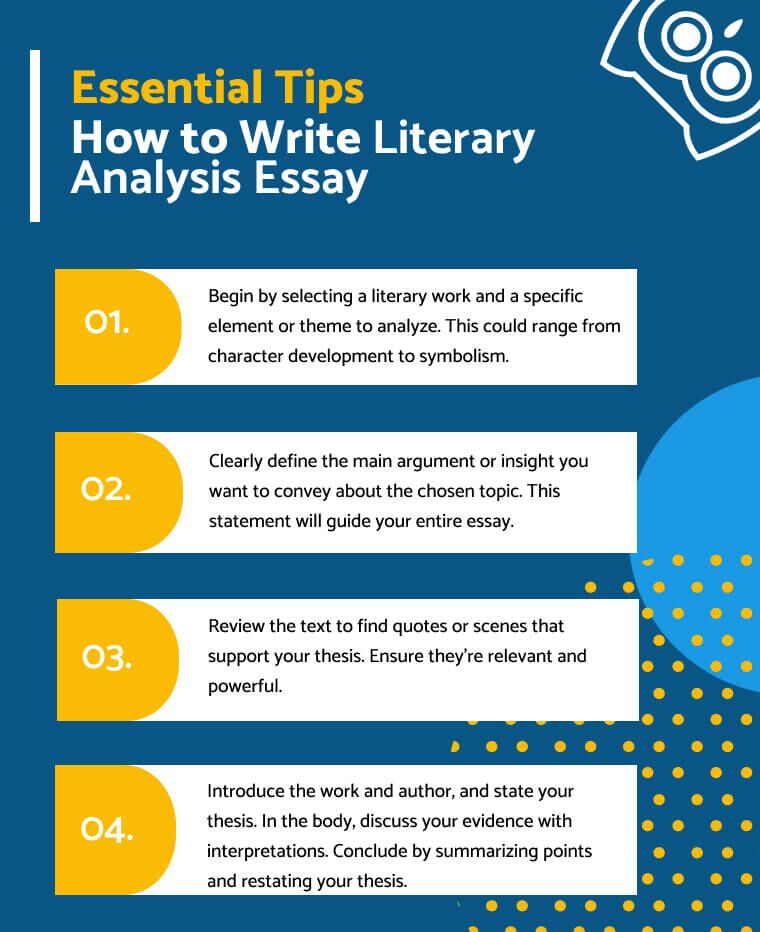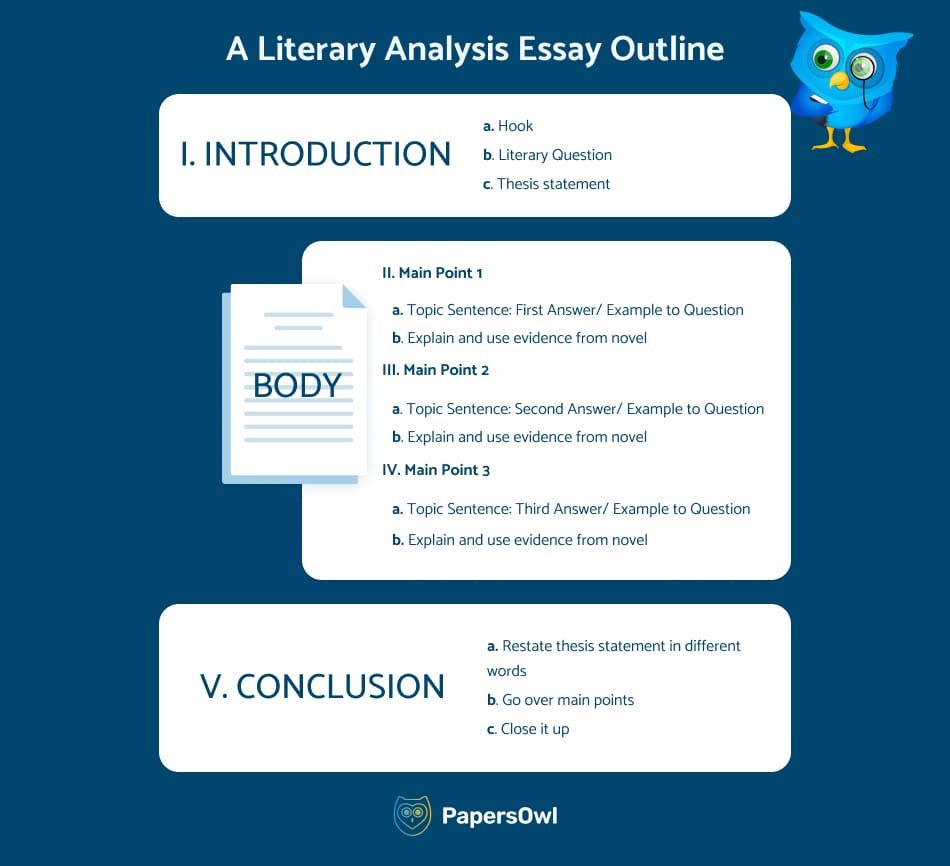
Writing a literary analysis essay is one of the most difficult tasks for a student. When you have to analyze a certain literary work, there is a whole set of rules that you have to follow. The literary analysis structure is rigid, and students often are demoralized by things like that.
Our article hopes to be a comprehensive guide that can explain how to write literary analysis essay. Here is what you will learn:
This way, you will be able to write an essay that has its own identity, its coherence, and great analytical power.

Let’s start with the first obvious step: understanding the assignment. This actually applies to all types of essays and more. Yet, it is an aspect still underestimated by many students. There are so many who rush headlong into a literary text analysis before even figuring out what they need to do. So, let’s see what are the real steps to follow before writing a literary analysis essay.
First, we need to understand why we are doing this and what is a literary analysis essay. The purpose of a literary analysis essay is to evaluate and examine a particular literary work or some aspect of it. It describes the main idea of the book you have read. You need a strong thesis statement, and you always have to make a proper outline for literary analysis essay.
Secondly, you always need to read the prompt carefully. This should serve as your roadmap, and it will guide you towards specific aspects of the literary work. Those are the aspects you will focus on. You should be able to get the main ideas of what to write already from the prompt. Failure to comprehend the prompt could invalidate the entire work and cause you to lose many valuable hours.
Great, so we understood what the purpose of a literary analysis is and that it is crucial to understand the prompt. Now, it’s time to do some preparatory work before you start your draft of the literary analysis paper.
When you write a literary analysis essay, the first thing you should do is select a topic. It is usually impossible to talk about a book or poem in its entirety. Choosing a more specific theme is essential. Firstly, because it will make your literary analysis paper more interesting. Secondly, it will also be easier for you to focus on a single aspect. This could be a single character or what style and literary techniques were used by the author.
At this point, it’s time to consider the broader context. For example, if you have picked a character, think about their character’s development and their significance. If you are analyzing literature looking for a specific theme, try to reflect on how it permeates the narrative and what messages it conveys.
Now, it’s time to frame your literary analysis thesis statement. This should be concise and clear. Think of it as the compass that will guide your analysis. Plus, if it’s clear to you, it’ll be clear to your reader as well. Do not underestimate this point because it can make everything way easier when you start. Finally, feel free to read another book review to get inspired.
It’s time to read the work you will analyze. We talk about what we call critical reading. This is the heart of all literary criticism, and it consists of immersing yourself in the story. Because of this, it is advised not to read the story just once but twice.
The first reading will serve to get a general understanding of the literary texts. This means comprehending the storyline, characters, and major plot developments. You should be able to enjoy it without thinking too much about the assignment. So don’t delve too deeply into analysis just yet.
Your second reading should be much more methodical. Here, you start analyzing things concretely without forgetting what your literary analysis thesis is. Resist the temptation to get lost in the narrative’s flow. Instead, go through a thorough examination and identify key literary elements and literary devices, like the plot, the character development, and the mood of the story. But also other literary elements: the symbolism, the protagonists, whether there is a first-person narrator or a third-person perspective, and whether the author uses figurative language when describing the main conflict.
Pay special attention to how these literary elements are interwoven into the narrative. For example, consider how character development influences the plot. Alternatively, how symbolism enhances the mood. Recognizing these connections will be crucial for your analysis. Finally, and this might be the hardest part, try to see how all of these literary analysis elements collectively contribute to the overall impact of the work. Ask yourself whether it all works together to convey the message the author wants to convey or not.
While reading, it’s important to take notes and annotate the text. Even a brief indication could be enough. You can do this to highlight passages or quotes that strike you as significant. But also to make connections between different parts of the story. These annotations and notes will become invaluable when you start a literary analysis essay.

Now that you’ve laid the groundwork, it’s time to craft your lit analysis piece. This section will help you do just that. The main points focus on:
Follow our suggestions, and you shouldn’t have any issues with your work. But, if you are facing a time crunch and need assistance with writing your literary essay, there is an online essay service that can help you. PapersOwl has been providing expert help to countless students with their literary essays for many years. Their team of professional writers is highly qualified and experienced, ensuring that you receive top-quality literary works. With PapersOwl’s assistance, you can rest assured that your literary essay will be well-written and thoroughly analyzed.
Before putting pen to paper, and even when you are familiar with the literary analysis format, take some time to consider your audience. Who are you writing for? Is it your professor or another reader? This will help you understand what type of analysis you are going to write.
If you are wondering how to choose a title, you should know that some prefer to choose it when they start, while others do it as the last thing before submitting it. Usually, the literary analysis title includes the author’s name and the name of the text you are evaluating. However, that is not always necessary. What matters is to make it brief and interactive and to catch the reader’s attention immediately.
Take this example of literary analysis: “Unmasking the Symbolism: The Enigmatic Power of the Green Light in The Great Gatsby”.
It works because, while introducing the story, it hints at the theme, the specific focus, and the intrigue of unraveling a mystery.
Writing a literary analysis essay starts with understanding the information that fills an outline. This means that writing details that belong in how to write an analytical essay should come fairly easily. If it is a struggle to come up with the meat of the essay, a reread of the novel may be necessary. Like any analysis essay, developing an essay requires structure and outline.
Let’s start with the first. Normally in high schools, the basic structure of any form of academic writing of a literature essay, comprises five paragraphs. One of the paragraphs is used in writing the introduction, three for the body, and the remaining literary analysis paragraph for the conclusion.
Every body paragraph must concentrate on a topic. While writing a five-paragraph structured essay, you need to split your thesis into three major analysis topics connected to your essay. You don’t need to write all the points derivable from the literature but the analysis that backs your thesis.
When you start a paragraph, connect it to the previous paragraph and always use a topic sentence to maintain the focus of the reader. This allows every person to understand the content at a glance.
After that, you should find fitting textual evidence to support the topic sentence and the thesis statement it serves. Using textual evidence involves bringing in a relevant quote from the story and describing its relevance. Such quotes should be well introduced and examined if you want to use them. While it is not mandatory to use them, it is effective because it allows to better analyze the author’s figurative language.
Let’s see a concrete literary analysis example to understand this.
✏️ Topic Sentence: In “The Great Gatsby,” Fitzgerald employs vivid descriptions to characterize Jay Gatsby’s extravagant parties.
✏️ Textual Evidence: Gatsby’s parties are described as “gaudy with primary colors” and filled with “music and the laughter of his guests”.
✏️ Literary Analysis: These vibrant descriptions symbolize Gatsby’s attempt to capture the essence of the American Dream. The use of “gaudy” highlights the emptiness of his pursuits.
Now that you know how to write a literature analysis, it’s crucial to distinguish between analysis and summary. A summary only restates the plot or events of the story. Analysis, on the other hand, tries to unveil the meaning of these events. Let’s use an example from another famous book to illustrate the difference.
✏️ Summary: In “To Kill a Mockingbird,” Atticus Finch defends Tom Robinson, an innocent Black man accused of raping a white woman.
✏️ Literary Analysis: Atticus Finch’s defense of Tom Robinson in “To Kill a Mockingbird” is a rather bitter commentary on the racial prejudices of the time. In the book, Harper Lee highlights the rampant racism that plagued Maycomb society.

The literature analysis essay, like other various academic works, has a typical 5-paragraph-structure. The normal procedure for writing an introduction for your literary analysis essay outline is to start with a hook and then go on to mention brief facts about the author and the literature. After that, make sure to present your thesis statement. Before going ahead, let’s use an example of a good literary analysis introduction. This will make it easier to discuss these points singularly.
“On the shores of East Egg, a green light shines through the darkness. The book is “The Great Gatsby” by F. Scott Fitzgerald, written in 1925, and this is not just a light. It’s much more. It symbolizes the American Dream chased and rejected by Gatsby and the other characters.”
As an introductory paragraph, this has all the characteristics we are looking for. First, opening statements like this introduce a mysterious element that makes the reader curious. This is the hook. After that, the name of the book, the author, and the release year are presented. Finally, a first glimpse of what your original thesis will be – the connection between the book and the topic of the American Dream.
Afterwards, you can finish writing the introduction paragraph for the literary analysis essay with a clue about the content of the essay’s body. This style of writing a literature essay is known as signposting. Signposting should be done more elaborately while writing longer literary essays.
In a literary analysis essay, the body paragraphs are where you go further into your analysis, looking at specific features of the literature. Each paragraph should focus on a particular aspect, such as character development, theme, or symbolism, and provide textual evidence to back up your interpretation. This structured approach allows for a thorough exploration of the literary work.
“In ‘The Great Gatsby,’ Fitzgerald uses the symbol of the green light to represent Gatsby’s perpetual quest for the unattainable – specifically, his idealized love for Daisy Buchanan. Situated at the end of Daisy’s dock, the green light shines across the bay to Gatsby’s mansion, symbolizing the distance between reality and his dreams. This light is not just a physical beacon; it’s a metaphor for Gatsby’s aspiration and the American Dream itself. Fitzgerald artfully illustrates this through Gatsby’s yearning gaze towards the light, reflecting his deep desire for a future that reconnects him with his past love, yet tragically remains just out of reach. This persistent yearning is a poignant commentary on the nature of aspiration and the illusion of the American Dream.”
The final paragraph, as usual, is the literary analysis conclusion. Writing a conclusion of your essay should be about putting the finishing touches on it. In this section, all you need to do is rephrase your aforementioned main point and supporting points and try to make them clearer to the person who reads them. But also, restate your thesis and add some interesting thoughts.
However, if you don’t understand how to write a conclusion and are just thinking, “Write my essay for me, please”, there are solutions. At PapersOwl, you get expert writers to help you with your analysis, ensuring you meet your deadline.
Let’s go back to Gatsby’s green light and look at how to write a literary analysis example of a good conclusion:
“Our journey through the green light of “The Great Gatsby” ends here. In this literary essay, we analyzed Fitzgerald’s style and the way this allowed him to grasp the secret of the American Dream. In doing so, we realized that the American Dream is not just about one person’s dream. Rather, it is about everyone who struggles for something that will never be realized.”
Here we have it all: restating the thesis, summing up the main points, understanding the literary devices, and adding some thoughts.
Catch plagiarism before your teacher does?Check your paper against billions of web pages and publications. Get an accurate Plagiarism-free content in a few seconds. It's fast, easy & free!

At this point, you’re almost done. After you write a literary analysis, it is usually time for a revision. This is where you have a chance to refine and polish your work.
Read your analysis of literature again to check coherence and consistency. This means that your ideas should flow smoothly into each other, thus creating a coherent narrative voice. The tone should always be consistent: it would be a terrible mistake to have a body written in a style and a conclusion in a different style.
Use this final revision to refine the thesis and overall the literary argument essay. If you see there are some flaws in your discourse or some weak and unsupported claims, this is your last chance to fix them. Remember, your thesis should always be clear and effective.
Finally, do not underrate the possibility of spelling and punctuation errors. We all make mistakes of that kind. Read your piece a few times to ensure that every word is written correctly. Nothing bad with a couple of typos, but it’s even better if there is none! Finally, check if you used transition words appropriately.
The revision process involves multiple rounds of review and refinement. You could also consider seeking feedback from peers or professors. This way, you could gain a new perspective on your literary analysis.
Catch plagiarism before your teacher does?Check your paper against billions of web pages and publications. Get an accurate Plagiarism-free content in a few seconds. It's fast, easy & free!

Educational institutions use works like the textual analysis essay to improve the learning abilities of students. Although it might seem complex, with the basic knowledge of how to go about it and the help of experts, you won’t find it difficult. Besides, if everything else fails, you can still try buying essays online at PapersOwl.
In this guide, we went through all the steps necessary to write a successful literary analysis. We began by understanding the assignment’s purpose and then explored preparatory work, the structure of a literature essay critical reading, and the actual crafting. In particular, we showed how to divide it into an introduction, body, and conclusion. Now it’s your turn to write a literary criticism essay!